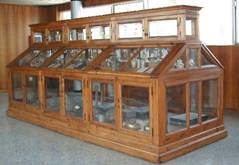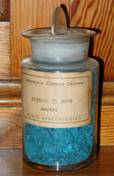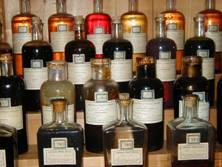The history

In order to settle the disputes that arose for the application of duties between importers and the State, the Financial Administration was obliged to resort to the work of experts that, based on the nature and composition of the goods had to provide the elements necessary to establish, with irrefutable scientific criteria, the legality and fairness of the same duties. Such thorough scientific investigation, entrusted to experts chosen on a case-by-case basis, involved an inevitable and uneconomic waste of time. To remedy this the Chemical Laboratory of “the Gabelle” was established following a proposal of Minister Magliani (Royal Decree No. 3929 of 7 June 1886).

The laboratory, based in Rome, was divided into two sections. The first carried out research, analysis, examinations of products and procedures relating to the handling and production of salt and tobacco, the second was in charge of quality controls on exported sugars and analyses for the exact application of the Customs Tariff. Due to the preponderance of the activity of the first section over the second, the Laboratory was inserted in the Private sector rather than in that of Customs.
After the reform of the General Directorate of the Gabelle undertaken in 1893 by Minister Gagliardo, the Chemical Laboratory became part of the Customs Administration. The responsibility of the first organization of the Labs of the Gabelle was entrusted to a scientist of considerable fame, Senator Stanislao Cannizzaro.
Among the many authoritative directors of the Customs Chemical Laboratories emerges the figure of Professor Vittorio Villavecchia, who is still an authority on the subject of commodities at the Higher Institute of Economic and Commercial Sciences in Rome. He is the author of the Dictionary of commodity and applied chemistry, still fundamental on the subject today.

It may be noted that modern commodities originated in the customs administration.
Referring to those Chemical Laboratories, as many as 11, which were already in operation in 1904, coordinated by the central one in Rome, science historian Antonio Di Meo said:
"An intense reworking of the very foundations and methods of commodity chemistry was undertaken in these laboratories, which in the future will take on a new face, since it was connected both to the most advanced results of analytical chemistry of the time and to the needs of production and trade of even completely new goods".
Bari
It was established on 15 July 1948 with jurisdiction over the territories included in the provinces of Bari, Campobasso, Foggia, Brindisi, Lecce, Matera, Taranto, Pescara, Chieti, L'Aquila and Teramo. In the first years, its activity was mostly absorbed by the local refinery and by the numerous distilleries existing in the provinces of its jurisdiction. From 1952 onwards, there has been a notable increase in the work activity due to the industrialization of the South. This gave rise to numerous industries to which the Bari Laboratory has made an important contribution by facilitating technological and commercial development. The continuous work carried out on behalf of the Guardia di Finanza must also be considered, for the purposes of surveillance and repression of fraud, in the interest of the Treasury and of individual industrial activities.
Bologna
It was established in 1903 as the "Sugar Chemical Cabinet", since it carried out almost exclusively analyses of sugar and similar products from the numerous sugar factories operating in the region.
Later the business extended to wines, flours and samples of chemical products.
After the Second World War, with the rise of numerous other industries in the area, the work activity underwent a significant increase.
Currently, the laboratory's activity concerns the factories in the industrial areas of Ferrara and Ravenna, as well as a large number of food and mechanical industries and 1st and 2nd category distilleries. Numerous Customs offices and 3 legion commands of the Guardia di Finanza report to the Bologna Laboratory, with their respective Tax Police Units. This represents an overview of the adaptation of the Financial Offices to the development of the area.
Cagliari
Law No. 645 of 6 August 1966 transformed the then "Cabinet of Chemical Sages of Customs and Indirect Taxes of Cagliari" into a regular departmental laboratory with competence throughout the territory and industries of Sardinia.
This institution became necessary following the growing industrialization of Sardinia, particularly in the petrochemical field.
Catania
It was established with Law No. 173, 14 March 1961. The Laboratory is managed by the Customs of Catania, Syracuse and Augusta and the U.T.F.
It operates in the provinces of Catania, Syracuse, Ragusa, Enna, where multiple industries are located, including several oil refineries and petrochemical industries.
The Chemical Laboratory proved immediately of great importance, both for the geographical position in which it is located, at the centre of a vast area of industrial complexes that became impressive in the space of a few years, and for having to meet the urgent daily requests of the Financial Offices of the area.
Genoa
It was established with Royal Decree No. 3991 of 25 July 1886, and began its activity in July 1887, one year after the foundation of the Central Chemical Laboratory of the Gabelle in Rome.
The work of the Genoa Laboratory is linked to the activity of one of the most important Customs offices in Italy, depending on the commercial interests that gravitate around the port of Genoa, also connected to the industries of Milan and Turin, as well as to transit traffic with Switzerland.
Numerous oil refineries operate in the Genoa area as well as factories for the production of lubricating oils and related products, as well as numerous minor factories.
The products of the many fat processing industries in the area, as well as various colour factories, are also subject to control.
Numerous samples are sent by the Tax Police for investigations into possible fraud concerning petroleum products, vegetable oils, beverages, etc.
Livorno
It was established with Royal Decree No. 93 of 21 March 1895, after those of Rome and Genoa. The timeliness of its establishment became more evident with the subsequent developments of the city's economy, favoured by a geographical position that made it the most important Tyrrhenian port of access to central Italy.
Currently the Laboratory carries out the analyses for the Customs of Livorno, La Spezia, Viareggio, Marina di Carrara, Piombino, Porto S. Stefano. The main industries that operate in the area are oil, steel, mechanical, oil and petrochemical, chemical, pharmaceutical and cosmetic industries of Pisa, tanning industries of S. Croce sull'Arno, food, clothing and clothing of Carrara-Avenza, mining industries.
Milan
The establishment of the Chemical Laboratory of Customs in Milan dates back to April 1901. Being the most industrialized area of Italy, the Laboratory immediately assumed paramount importance for the variety of products examined and for the complexity of the customs classifications, relating to the various imported goods.
As a result of the considerable increase in industrial production, which has occurred on a national scale, and particularly in Lombardy, and which has obviously caused an enormous exchange of raw materials, intermediate chemicals and finished products, the importance and complexity of the activities carried out by the Laboratory have proportionally increased in recent years.
The development of the processing of foreign goods in temporary importation on behalf of foreign client companies resulted in the need to examine a large number of products of the most advanced technology and to carry out checks on the related processing industry, through numerous inspections in the factories located in the territorial district of competence.
The growth of motorization and the consequent evolution of the oil and petrochemical industry also had a decisive influence on the work of the Chemical Laboratory of Milan.
The Como Customs Chemical Laboratory branch section, which has been carrying out analytical activities in the textile sector since 1967, has been definitively closed and transferred to the Milan Laboratory.
Naples
Established in 1901 with Royal Decree No. 53 of 24 February 1901, the Naples Laboratory was for a long time the only laboratory for Southern Italy and Sicily.
Due to the strong flow of exports of pasta, flours, fats and oils, especially for soaps, as well as an intense trade of various canning products, its activity has been intense since the beginning.
The setting up of the Laboratory of Palermo in 1939 and of Bari in 1948, has halved the territory of jurisdiction of the Naples Laboratory, however its activity is still considerable.
The main industries in the area are petroleum, petrochemical and electronic, steel, pharmaceutical, confectionery, canning, food and milling.
Palermo
The Laboratory was established with Royal Decree No. 1922 of 27 October 1937, and carries out a large internal activity performing analyses required by national and regional bodies and an external activity in the industries to which it offers consultancy services, especially in the field of complex fertilizers.
Rome
The Rome Customs Chemical Laboratory was set up with Legislative Decree No. 105 of 2 March 1992 together with the DCAMLC (Central Directorate for Merchandise Analysis and the Chemical Laboratory).
It is the technical consultancy body of the offices dependent on the Regional Departments of Rome and Ancona.
At the beginning, it was recognized as a Specialized Laboratory in the field of olive oils, being also the site of the Panel Test. With the abolition of the Central Management, AMLC acquires the analytical certification activity, expanding its skills, and acquiring the specialized departments of textiles, metals and mineral oils.
Since 1995, the Laboratory has been transferred from the historic headquarters in Trastevere, in via della Luce, to via Mario Carucci 71, headquarters of the Excise Customs and Monopolies Agency.
Savona
It was established with Law No. 173 of 14 March 1961, and began its activities on July 15, 1966 to ensure greater promptness in operations and a more complete control of tax interests at the Customs of Savona.
The Laboratory undertakes the chemical analyses and investigations required by the Customs District of Imperia, by the Border Customs of Ventimiglia, as well as by the Command of the Guardia di Finanza of the Riviera di Ponente.
The most relevant products are vegetable oils and fats, cereals, food and beverages, chemicals and mineral oils.
Turin
It was established with Royal Decree No. 239 of 2 July 1902 and began to operate in September 1903. Its original purpose was the analysis of confectionery products, which already flowed in considerable numbers at the time. Over the years, the product composition of the analysed samples has undergone considerable variations: currently food products make up about 50% of the analytical work. These products are, among others, wines, vermouth and confectionery products in general, which require particularly accurate analyses, concerning the controversial field of possible food fraud. Analyses also target ferrous materials. Marc spirits are also of particular importance, following the application of the Health Law, which imposed control over the entire production.
Trieste
Established with Royal Decree No. 1922 of 27 October 1937, the Laboratory began its activity on 1 September 1938, together with the Laboratory of Palermo, established by the same decree.
Initially the competence of the Laboratory extended to the districts of Fiume, Trieste and Udine. With the post-war events, the parenthesis of a very delicate period began for the Trieste Laboratory, during which its jurisdiction was reduced to only "T.L.T." (Free Territory of Trieste), administered by the Anglo-Americans. Located on the extreme eastern gate of the national territory, the Trieste Laboratory analyses the goods related to the significant flow of exports of industrial products to Eastern European and Middle Eastern countries, with a less industrialized economy, counterbalanced by intense imports of raw materials and agricultural products. The Laboratory is called to express itself on the tax treatment to be applied to the products of the various important industries of the Region, which produce a wide range of products subject to manufacturing tax (from beer, liqueurs, mineral oils, edible oils).
Venice
Established with Royal Decree No. 500 of November 1896, it was installed above the general warehouses of S. Marta overlooking the Giudecca canal, thus becoming part of the very life of the port of Venice at the time. The expansion of the industries in the area, the new port works, and the damage suffered particularly by the Laboratory during the Second World War, made it necessary to move the Laboratory to Venice Mestre, in a more centralized area in the industrial context of Porto Marghera. In this area, there are numerous industrial factories for petroleum and petrochemical products, metallurgical, textile, cardboard and glass processing, oil and food production as well as important shipyards. The Venice Lab also supervises the industries of the provinces of Padua, Treviso, Vicenza, Belluno and Udine, including textile and manufacturing industries, spirits and beer. In connection with Customs, the Laboratory carries out the analytical control of goods in import and export for their exact customs classification.
Verona
It was established with the Royal Decree No. 239 of 2 July 1902, mainly for the analysis of sugar and confectionery products. Its activity soon extended to other categories of products, because of the industrialization of the territory and the intensification of trade with foreign countries and particularly with Germany.
In the course of World War II, the Laboratory was destroyed and continued its activity for some years at the Venice Laboratory (Verona Laboratory in Venice). In 1954, the Laboratory was transferred back to Verona. Since then, it carries out numerous factory inspections for the definition of temporary imports in the chemical, oil, steel, textile and paper industries in the area.